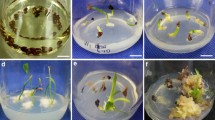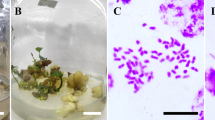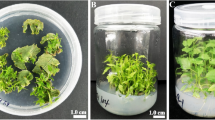Abstract
Many diploid rose species and cultivars possess valuable traits that can be introgressed into modern tetraploid cultivars. Interspecific, interploidy crosses are possible, but triploid hybrids typically have limited fertility, hindering further breeding and selection. Tetraploidizing diploids before mating with tetraploids can alleviate fertility barriers. The efficiency of trifluralin was investigated for polyploidization of Rosa chinensis minima (2n = 2x = 14) seedlings. Treatments were trifluralin at 0.086% and 0.0086%, colchicine (0.5%), and distilled water and contained 2% dimethyl sulfoxide and a surfactant. Approximately 5 μl of the treatment solution was applied to the apical meristem of seedlings (N = 337, 82–85 per treatment) in the process of cotyledon expansion. Guard cell length, pollen diameter, and root tip squashes of rooted cuttings were used to detect polyploidy in meristematic layer (L)I, LII, and LIII, respectively. Trifluralin (0.086%) was the most effective treatment for polyploidization (LI 20.2%, LII 12.9%, LIII 12.9%), followed by trifluralin (0.0086%) (LI 10.6%, LII 7.1%, LIII 4.7%) and colchicine (LI 2.4%, LII 0%, LIII 0%). Polyploidization consistently occurred from LI inward. Polyploids as a group had reduced pollen stainability and a lower leaflet length to width ratio than diploids. In addition, two diploid seedlings were identified which produce 2n pollen. Considerations in selecting germplasm and generating somatically-induced polyploids from seedlings versus clones for use in breeding are discussed.
Similar content being viewed by others
References
Bartels, P.G. & J.L. Hilton, 1973. Comparison of trifluralin, oryzalin, pronamide, propham and colchicines treatments on microtubules. Pest biochem physiol 3: 462–472.
Basye, R.E., 1990. An amphidiploid of Rosa banksiae and Rosa laevigata induced by colchicine. Amer Rose Ann 75: 83–87.
Blakeslee, A.F. & A.G. Avery, 1937. Methods of inducing doubling of chromosomes in plants by treatment with colchicine. J Hered 28: 393–411.
Cairns, T. (Ed.), 2000. Modern Roses XI, The World Encyclopedia of Roses, Academic Press, San Diego.
Crespel, L., S. Gudin, J. Meynet & D. Zhang, 2002. AFLP-based estimation of 2 n gametophytic heterozygosity in two parthenogenetically derived dihaploids of Rosa hybrida L. Theor Appl Genet 104: 451–456.
Eeckhaut, T.G.R., S.P.O. Werbrouck, L.W.H. Leus, E.J. Van Bockstaele & P.C. Debergh, 2004. Chemically induced polyploidization in Spathiphyllum wallisii Regel through somatic embryogenesis. Plant Cell Tiss Org Cult 78: 241–246.
Eigsti, O.L. & P. Dustin, Jr., 1957. Colchicine – In agriculture, medicine, biology, and chemistry. The Iowa State College Press, Ames.
El Mokadem, H., L. Crespel, J. Meynet & S. Gudin, 2002a. The occurrence of 2 n-pollen and the origin of sexual polyploids in dihaploid roses (Rosa hybrida L.). Euphytica 125: 169–177.
El Mokadem, H., J. Meynet & L. Crespel, 2002b. The occurrence of 2 n eggs in the dihaploids derived from Rosa hybrida L. Euphytica 124: 327–332.
Erlanson, E.W. 1931. A group of tetraploid roses in central Oregon. Bot Gaz 91: 55–64.
Esau, K., 1977. Anatomy of Seed Plants. Wiley, New York.
Hansen, A.L., A. Gertz, M. Joersbo & S. B. Anderson, 1998. Antimicrotubule herbicides for in vitro chromosome doubling in Beta vulgaris L. ovule culture. Euphytica 101: 231–237.
Hansen, N.J.P. & S.B. Anderson, 1998. Efficient production of doubled haploid wheat plants by in vitro treatment of microspores with trifluralin or APM. Plant Breed 117: 401–405.
Hassawi, D.S. & G.H. Liang, 1991. Antimitotic agents: Effects on double haploid production in wheat. Crop Sci 31: 723–726.
Horst, R.K., 1983. Compendium of Rose Diseases, APS Press, St. Paul, Minnesota.%
Kermani, M.J., V. Sarasan, A.V. Roberts, A. Yokoya, J. Wentworth & V.K. Sieber, 2003. Oryzalin-induced chromosome doubling in Rosa and its effects on plant morphology and pollen viability. Theor Appl Genet 107: 1195–1200.
Krüssmann, G., 1981. The Complete Book of Roses, Timber Press, Portland, Oregon.
Luckett, D.J., 1989. Colchicine mutagenesis is associated with substantial heritable variation in cotton. Euphytica 42: 177–182.
Ma, Y., D.H. Byrne & J. Chen, 1997. Amphidiploid induction from diploid rose interspecific hybrids. Hort Sci 32: 292–295.
Ma, Y., C.F. Crane & D.H. Byrne, 2000. Meiotic behavior in a tetraploid rose and its hybrids. Hort Sci 35: 1127–1131.
Ramulu, K.S., H.A. Verhoeven & P. Dijkhuis, 1991. Mitotic blocking, micronucleation, and chromosome doubling by oryzalin, amiprophos-methyl, and colchicine in potato. Protoplasma 160: 65–71.
Roberts, A.V., D. Lloyd & K.C. Short, 1990. In vitro procedures for the induction of tetraploidy in a diploid rose. Euphytica 49: 33–38.
Rowley, G.D., 1960. Triploid garden roses. Amer Rose Ann 45: 108–113.
Sanders, M.E. & C.J. Franzke, 1960. Colchicine-induced complex diploid mutants from tetraploid seedlings. J Hered 60: 137–148.
Semeniuk, P. & T. Arisumi, 1968. Colchicine-induced tetraploid and cytochimeral Roses. Bot Gaz 129: 190–193.
Simantel, G.M. & J.G. Ross, 1963. Colchicine-induced somatic chromosome reduction in sorghum. III. Induction of plants homozygous for structural chromosome markers in four pairs. J Hered 54: 277–284.
SPSS Inc., 1997. Statistical product and service solutions user’s guide, SPSS base 7.5 for windows. SPSS Inc. Chicago.
Tai, G.C.C. & H. DeJong, 1997. A comparison of performance of tetraploid progenies produced by diploid and their vegetatively doubled (tetraploid) counterpart parents. Theor Appl Genet 94: 303–308.
Tilney-Bassett, R.A.E., 1986. Plant Chimeras. Edward Arnold, London, UK.
Tomlin, C.D.S. (Ed.), 1997. The Pesticide Manual. British Crop Protection Council, Surry, U.K.
United States Department of Agriculture, 2004. Floriculture crops 2003 summary. Sp Cr 6-1 (04) a, http://usda.mannlib.cornell.edu/reports/nassr/other/zfc-bb/floran04.pdf.
von Malek, B. & T. Debener, 1998. Genetic analysis of resistance to black spot (Diplocarpon rosae) in tetraploid roses. Theor Appl Genet 96: 228–231.
Wan, Y., D.R. Duncan, A.L. Rayburn, J.F. Petolino & J.M. Widholm, 1991. The use of antimicrotubule herbicides for the production of doubled haploids plants from anther-derived maize callus. Theor Appl Genet 81: 205–211.
Wright, P.H., 1947. The interactions of various rose species. Am Rose Ann 32: 169–172.
Zlesak, D.C. & C.A. Thill, 2002. Variation for 2 n pollen production and male fertility in wild Solanum germplasm resistant to Phytophthora infestans (Mont.) de Bary (US8). Am J Potato Res 79: 219–229.
Author information
Authors and Affiliations
Corresponding author
Rights and permissions
About this article
Cite this article
Zlesak, D.C., Thill, C.A. & Anderson, N.O. Trifluralin-mediated polyploidization of Rosa chinensis minima (Sims) Voss seedlings. Euphytica 141, 281–290 (2005). https://doi.org/10.1007/s10681-005-7512-x
Received:
Accepted:
Issue Date:
DOI: https://doi.org/10.1007/s10681-005-7512-x




